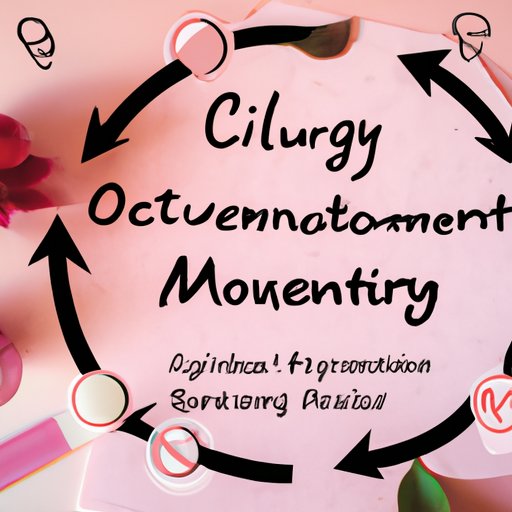
I. Introduction
Knowing when you’re ovulating is an essential part of the fertility journey, whether you’re trying to conceive or trying to avoid pregnancy. Having this knowledge can help you identify your fertile window, predict your menstrual cycle, and take the necessary steps to maximize your chances of conceiving. There are different ways to track ovulation, from understanding your menstrual cycle to monitoring your body temperature or cervical mucus changes.
II. Tracking Your Menstrual Cycle: A Beginner’s Guide to Understanding Ovulation
Understanding your menstrual cycle is the first step in tracking ovulation. The menstrual cycle refers to the series of hormonal changes that occur in a woman’s body over the course of a month, leading to menstruation. The cycle has different phases, including the follicular phase, ovulation, and the luteal phase.
Ovulation is the most crucial phase of the menstrual cycle. It’s when the ovaries release an egg, which can be fertilized by sperm. Ovulation typically occurs around day 14 of a 28-day menstrual cycle, but this can vary from person to person, and a cycle can range from 21 to 35 days.
The easiest way to track your menstrual cycle is by using a calendar. Mark the first day of your period as day one and count the days until your next period. Keep track of the length of your cycle for a few months to identify any patterns and predict when you’re likely to ovulate.
III. Signs Your Body Is Telling You It’s Time: How to Recognize Your Ovulation Symptoms
Aside from tracking your menstrual cycle, your body can give you clues about when you’re ovulating. Some women experience physical and emotional symptoms, such as breast tenderness, abdominal bloating, and increased libido.
One of the most reliable signs of ovulation is changes in cervical mucus, which becomes more abundant, stretchy, and clear during ovulation. You can track these changes by checking your cervical mucus daily and noting its consistency and color. Another way to detect ovulation is by using an ovulation predictor kit (OPK), which measures the levels of luteinizing hormone (LH) in your urine.
IV. The Science of Ovulation: How Tracking Your Body Temperature Can Help Determine Your Fertile Days
Monitoring your basal body temperature (BBT) is another way to track ovulation. Your BBT is your body’s lowest temperature when you’re at rest, and it increases slightly after ovulation due to a surge in progesterone levels. You can track your BBT by taking your temperature at the same time every morning before getting out of bed and charting it on a graph.
One of the benefits of using BBT to track ovulation is that it can help you predict your fertile days, which are the days leading up to and including ovulation, when you’re most likely to conceive. However, BBT tracking has some limitations, such as the fact that it can only confirm ovulation after it has occurred, and stress, illness, and alcohol can affect your temperature readings.
V. Maximizing Your Chances of Conception: Finding Your Fertile Window Through Ovulation Predictor Kits
Using an OPK is another method to predict your fertile window and maximize your chances of conception. OPKs work by detecting the surge of LH in your urine, which typically occurs 24-48 hours before ovulation. You can buy OPKs over the counter at most drugstores and follow the kit’s instructions to use them.
One of the benefits of using OPKs is that they can help you pinpoint your exact fertile days and time intercourse accordingly. However, they have some limitations, such as their cost and the fact that they can’t confirm ovulation, only predict it. It’s essential to use OPKs in combination with other methods like BBT tracking or cervical mucus observation for the most accurate results.
VI. Natural and Holistic Methods for Tracking Your Ovulation Cycle
Aside from traditional methods like calendars and OPKs, some natural and holistic methods can help you track your ovulation cycle. These methods are based on observing your body’s natural signs and changes, such as cervical mucus, basal body temperature, and other symptoms.
One of the most popular and reliable natural methods is the cervical mucus method, where you track changes in your mucus throughout your cycle to predict ovulation. Another method is the calendar rhythm method, where you calculate your fertile window based on your menstrual cycle average length. The symptothermal method combines various signs like cervical mucus and BBT tracking to confirm ovulation and identify your fertile days.
In addition to these methods, some holistic approaches can boost your fertility, such as adopting a healthy diet rich in fruits, vegetables, and whole grains, and reducing stress through meditation or yoga.
VII. Overcoming Fertility Challenges: Understanding Ovulation as a Key Factor in Conception
Fertility challenges can arise due to different factors, including age, health conditions, and lifestyle choices. One key factor in conception is ovulation, making it essential to identify and track your fertile window.
If you’re having difficulties getting pregnant, seeking medical help from a fertility specialist, and undergoing medical treatments like assisted reproductive technologies (ART) or in-vitro fertilization (IVF) can increase your chances of success. Lifestyle changes like quitting smoking, reducing alcohol and caffeine intake, and achieving a healthy weight can also improve your fertility outcomes.
VIII. Conclusion
In conclusion, tracking your ovulation is an essential part of maximizing your chances of conceiving. There are different ways to track ovulation, from monitoring your menstrual cycle to observing your cervical mucus, measuring your BBT, and using OPKs. Natural and holistic methods like the cervical mucus method and the calendar rhythm method can complement traditional methods.
If you’re having challenges getting pregnant, understanding ovulation is one key factor that can help you overcome these challenges. Seeking medical help and making lifestyle changes can also increase your chances of success. Remember that every woman’s body is unique, and finding what works for you may take some time. With patience, persistence, and knowledge, you can increase your chances of achieving your fertility goals.





